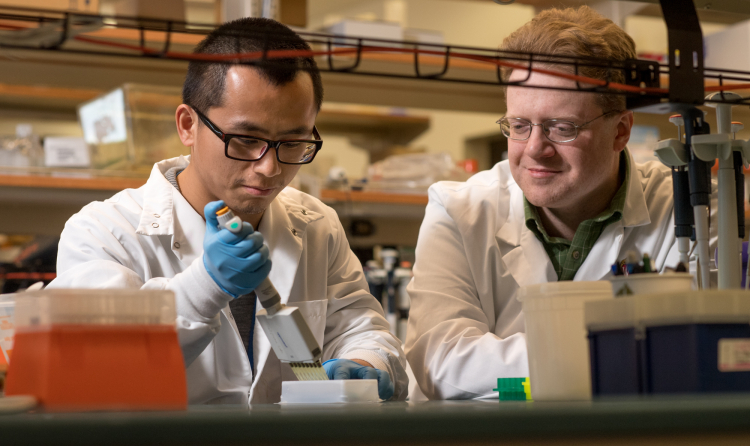Lamming lab makes new progress in developing interventions to promote healthy aging

Two recently published papers from the laboratory of Dudley Lamming, PhD (pictured above with graduate student Deyang Yu), assistant professor, Endocrinology, Diabetes and Metabolism, broke new ground in understanding the biology of a key protein that regulates metabolism and aging, and in identifying a drug that may be able to safely extend healthy lifespan.
For over a decade, the scientific community has had an interest in mechanistic Target Of Rapamycin (mTOR), a protein that in 2003 was discovered to regulate the lifespan of worms. Subsequent work has shown that rapamycin, an inhibitor of mTOR used in humans to prevent rejection after organ transplantation, extends the lifespan of yeast, worms, flies and mice. It also prevents or delays the onset of Alzheimer’s disease in mice if given before systems arise.
But rapamycin’s strong immunosuppressive properties and negative metabolic side effects limit its potential use in humans.
In 2012, Dr. Lamming discovered that rapamycin’s effects on the health and longevity of mice are mediated by inhibition of two distinct protein complexes, mTORC1 and mTORC2. The beneficial effects of rapamycin on aging are mediated by inhibition of mTORC1, while many of the side effects of rapamycin result from inhibition of mTORC2. (Read related article from a Discovery Magazine blog.)
Dr. Lamming hypothesized that new compounds that specifically inhibit mTORC1 would promote healthy aging with fewer of rapamycin’s drawbacks.
In a recent paper, published in Nature Communications on July 19, 2019, Dr. Lamming and collaborators at the Buck Institute and at Aeonian Pharmaceuticals, the latter of which helped fund the research, identified a new analog of rapamycin, DL001, that is 40 times more selective for mTORC1 than rapamycin itself. The research team showed in vivo that DL001 effectively inhibits mTORC1 without the side effects—including glucose intolerance and hyperlipidemia—traditionally associated with rapamycin.
Dr. Lamming’s team is also seeking to better understand the role of mTORC2 in age-related metabolic processes. In the mouse hypothalamus, a part of the brain that plays a crucial role in regulating metabolism, Dr. Lamming and collaborators found that mTORC2 signaling typically increases with age. In a new paper, published in Aging Cell on August 1, 2019, the team used genetic mouse models to discover that inhibiting hypothalmic mTORC2 increased inactivity, obesity and frailty; impaired glucose regulation; and decreased lifespan.
“Our results demonstrate a key role of hypothalamic mTORC2 in the regulation of metabolism, fitness and longevity, and suggest that inhibition of this complex by pharmaceuticals must be approached with caution,” the authors wrote.
By continuing to investigate the molecular pathways of aging—and the impact of rapamycin and its analogs on those pathways—Dr. Lamming hopes to get closer to identifying future therapies for age-related diseases.
“Rapamycin controls the mTOR pathway, and inhibiting mTORC1 upregulates pathways that are involved in recycling and repairing cells and organisms in the body,” he explains.
“Think of it like repairing and maintaining a city’s existing highways and bridges, instead of replacing them,” he continues. “Our goal is to find ways to preserve the body’s infrastructure as its ages.”
Resources:
- Schreiber KH, Arriola Apelo SI, Yu D, Brinkman JA, Velarde MC, Syed FA, Liao CY, Baar EL, Carbajal KA, Sherman DS, Ortiz D, Brunauer R, Yang SE, Tzannis ST, Kennedy BK, Lamming DW. A novel rapamycin analog is highly selective for mTORC1 in vivo. Nat Commun. 2019 Jul 19;10(1):3194. doi: 10.1038/s41467-019-11174-0. PubMed PMID: 31324799; PubMed Central PMCID: PMC6642166.
- Chellappa K, Brinkman JA, Mukherjee S, Morrison M, Alotaibi MI, Carbajal KA, Alhadeff AL, Perron IJ, Yao R, Purdy CS, DeFelice DM, Wakai MH, Tomasiewicz J, Lin A, Meyer E, Peng Y, Arriola Apelo SI, Puglielli L, Betley JN, Paschos GK, Baur JA, Lamming DW. Hypothalamic mTORC2 is essential for metabolic health and longevity. Aging Cell. 2019;00:e13014. 21https://doi.org/10.1111/acel.13014
- Yong E. The two faces of rapamycin – why a life-extending drug also increases risk of diabetes. Discover Magazine’s Not Exactly Rocket Science Blog .XUmTTC2ZOi4. Published March 30, 2012. Accessed August 6, 2019.
- Lamming DW, Ye L, Katajisto P, Goncalves MD, Saitoh M, Stevens DM, Davis JG, Salmon AB, Richardson A, Ahima RS, Guertin DA, Sabatini DM, Baur JA. Rapamycin-induced insulin resistance is mediated by mTORC2 loss and uncoupled from longevity. Science. 2012 Mar 30;335(6076):1638-43. doi: 10.1126/science.1215135. PubMed PMID: 22461615; PubMed Central PMCID: PMC3324089.